My Health Condition
I have a health problem characterized by pain in my forehead every hour of every day. I also get migraine attacks a few times a week. The migraine attacks started gradually around 2018, and the persistent head pain started more recently. Here are some treatments I have tried: magnesium, sumatriptan, amitriptyline, riboflavin, coenzyme Q10, Nurtec (rimegepant), propranolol, Emgality (galcanezumab), topiramate. I am currently (2023) writing down my health experiences in a Google sheet. I record text and tabular data for each day. I have written python programs that analyze this data.
Here are some findings:
Attack Frequency by Day of Week
For years, I have been much more likely to have migraine attacks on Sundays than other days of the week. In the date range shown on the following graph, I recorded a migraine attack on 47% of Sundays, 19% of Mondays, 25% of Tuesdays, 15% of Wednesdays, 22% of Thursdays, 20% of Fridays, and 16% of Saturdays.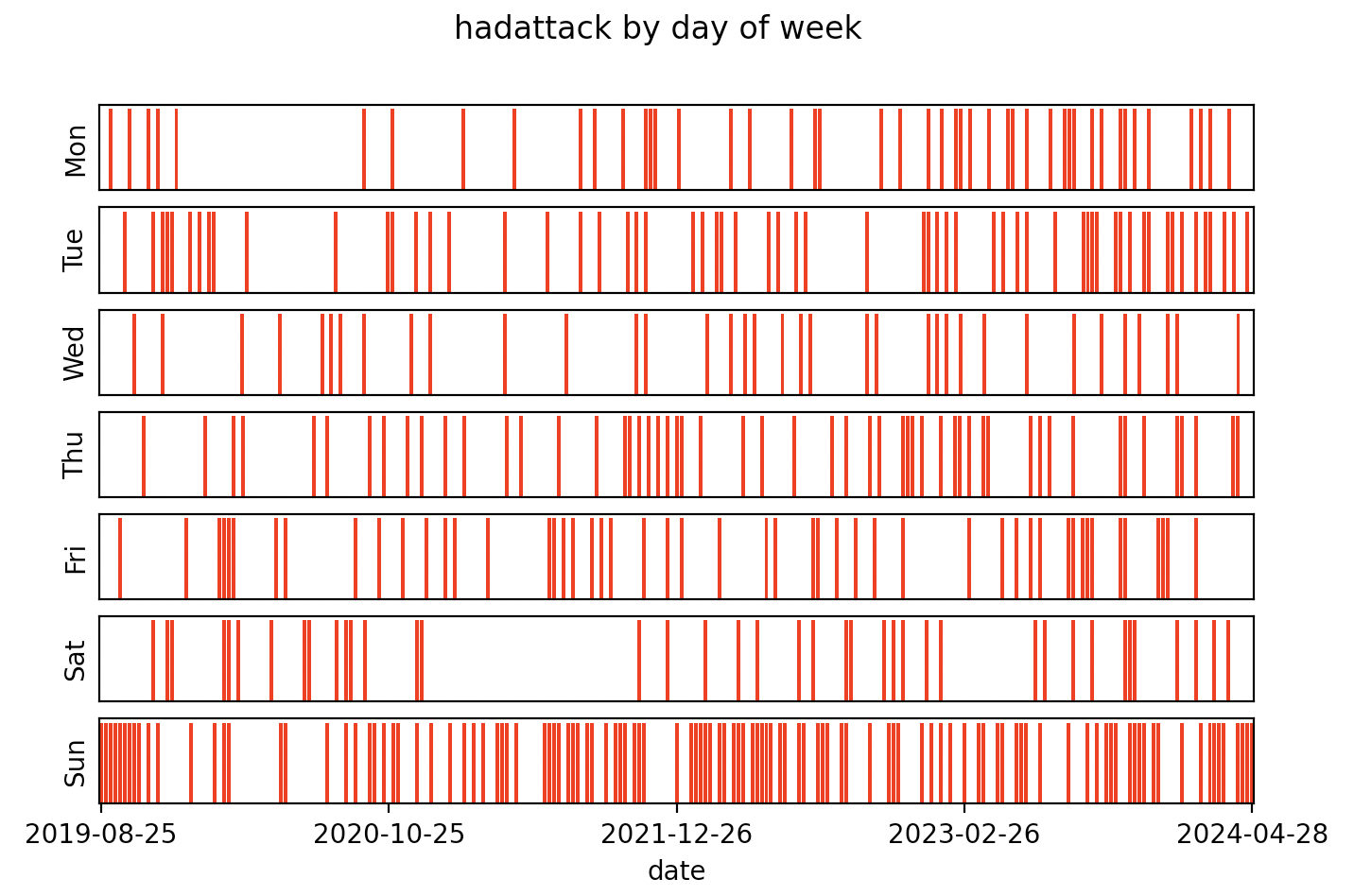
I do not know why I have so many more migraine attacks on Sundays than other days of the week. It is very valuable for me to know, so I am experiementing with my Sunday routine to see what affects the attacks.
Ibuprofen
Ibuprofen was the first medication I tried for head pain. I first took ibuprofen when my head pain was just beginning in 2018. I knew that my mother had taken ibuprofen for her migraines for many years. In 2019, I came to believe that ibuprofen didn't work. There was also a time when I told my doctor that ibuprofen caused head pain the next day. I took ibuprofen many times for migraine attacks in 2019 and 2020. I believed it didn't work, but I often took it anyway, often because my parents wanted me to take it. I took either one, two, or three 200mg tablets at once as an abortive. By 2021, I had stopped taking ibuprofen. There were only three occasions when I took ibuprofen in 2021 and 2022 combined.
After a breakup with my neurologist in late 2022, I didn't have a prescription to Nurtec. I didn't believe Nurtec worked, because I had done a trial in which I flipped a coin to determine whether to take Nurtec on 44 Sunday mornings and found no relationship between whether I took Nurtec and any metrics of my head pain. So I was in a position where ibuprofen was the medication to try, since it doesn't require a prescription from a physician.
My Placebo-Controlled Trial of Ibuprofen
In early 2023, I started a randomized, placebo-controlled trial of ibuprofen. This kind of trial is known for its use by professionals on large numbers of patients, but I employed this technique for myself.
The trial consisted of a number of rounds that ended up being three. For each round, I put two capsules in each of ten small resealable plastic bags. For five of each round's bags, each capsule contained a 200mg tablet of ibuprofen, for a total of 400mg of ibuprofen in the bag. For the other five bags, each capsule contained a placebo. I did a lot of experimenting with placebos to minimize the chance of knowing whether a bag was ibuprofen or placebo on the day of taking it. The biggest factor for placebo selection was the sound when the capsule is handled. In the first round, I used pepitas as the placebos. In the second round I used small pinto beans. And in the third round I used small white beans.
I prepared each bag together with a plastic cup that would store whether the bag contained ibuprofen or placebo. I put a note on the inside of each cup saying whether it was ibuprofen or placebo, then I shuffled the cups with the bags in them. Then I removed the bags from the cups one at a time, putting a number from 1 to 10 on each bag and on the outside of its corresponding cup, being careful not to see the note on the inside of the cup. Then I put the bags in my backpack, and I put the cups in a secure location. The cups were stored upside down to prevent me from seeing the notes on the inside of the cups.
Once a round was set up, I waited for migraine attacks. I took each bag when I was having a migraine attack, just like I would if I was taking ibuprofen normally. I never took more than one bag in one day. Whenever I took the contents of a bag, I recorded the number of the bag in my Google Sheet.
I record data about the head pain intensity at points in time throughout the duration of each attack. I intend these numbers to be on the 10-point pain scale, but I almost never record a value less than 3/10 because I am never free of head pain. I have been recording head pain data during migraine attacks since 2021, so I didn't have to start doing it for this ibuprofen trial. It seems to be a response I have when I experience pain. Some might call it a coping behavior.
At the end of each round, I used the note inside each cup to determine whether the corresponding bag contained ibuprofen or placebo. Then I used a python program to analyze the results. The algorithm used by the python program is a bit complicated. It takes the average head pain over time from the time of treatment to the last recording of the day, and subtracts the head pain at the time of the treatment from that, and uses a few statistical methods to see if that number correlates with whether the bag contained ibuprofen or placebo.
Here is a self-contained version of the python program.
Results
The number described in the previous paragraph correlated with whether the bag contained ibuprofen with a correlation coefficient around -0.55 and a p-value around 0.002. This means that 400mg ibuprofen is highly effective at reducing head pain in the hours following its consumption.
This dot plot shows the numbers used in the analysis. The key observation is that the dots in the ibuprofen category tend to be further to the left than the dots in the placebo category.
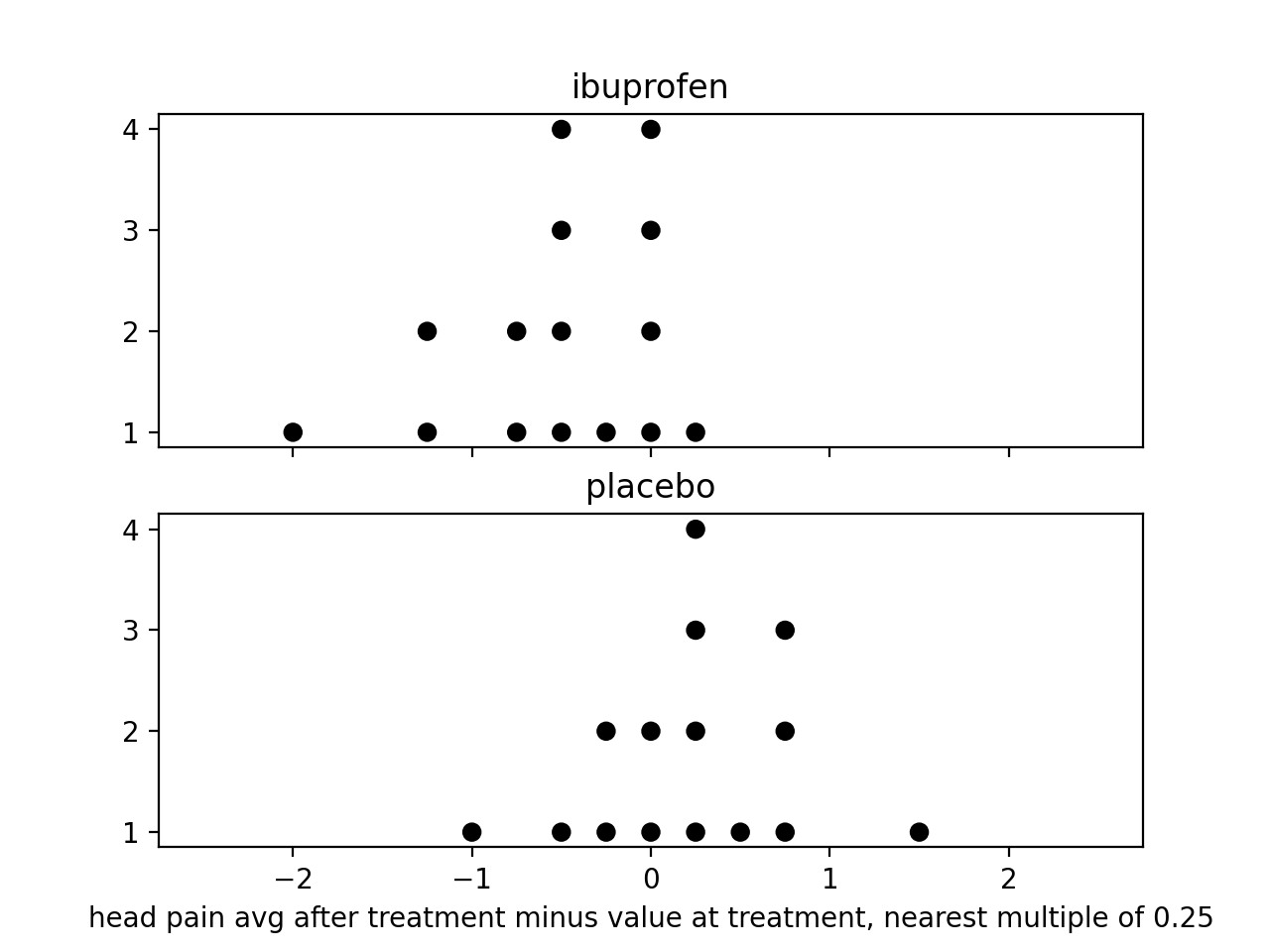
During the third and final round of the trial, I experienced health anxiety, fearing that I was damaging by body by taking the ibuprofen. However, in analysis I found that my perception of side effects was at least partially placebo effect. Notably, on 2023-10-08 I wrote, "Ok, this is definitely a side effect of ibuprofen", but that bag was placebo.
This trial was extremely successful from my point of view. When I started the trial, I was not expecting ibuprofen to perform well. Now I know that ibuprofen is highly effective as an abortive for my migraine attacks.
I wish I could do a similar trial with Nurtec. Unfortunately, I don't think I will be able to repeat this with Nurtec because I don't have any ideas for the placebo. The directions of Nurtec say not to store it out of its wrapper, and it is supposed to be dissolved in the mouth (as an orally disintegrating tablet) rather than being swallowed whole.
Propranolol
Propranolol is one of the many medications I have been prescribed. As a nonselective beta blocker, propranolol's primary action is reducing pulse [1][2]. To measure my pulse, I have been using a mobile app called StressCam. This app is old, so its website, stress-cam.com, has been taken down. It only works on my older iPhone and not my newer one.The following image shows that propranolol lowered my pulse. The dosage of propranolol varied.
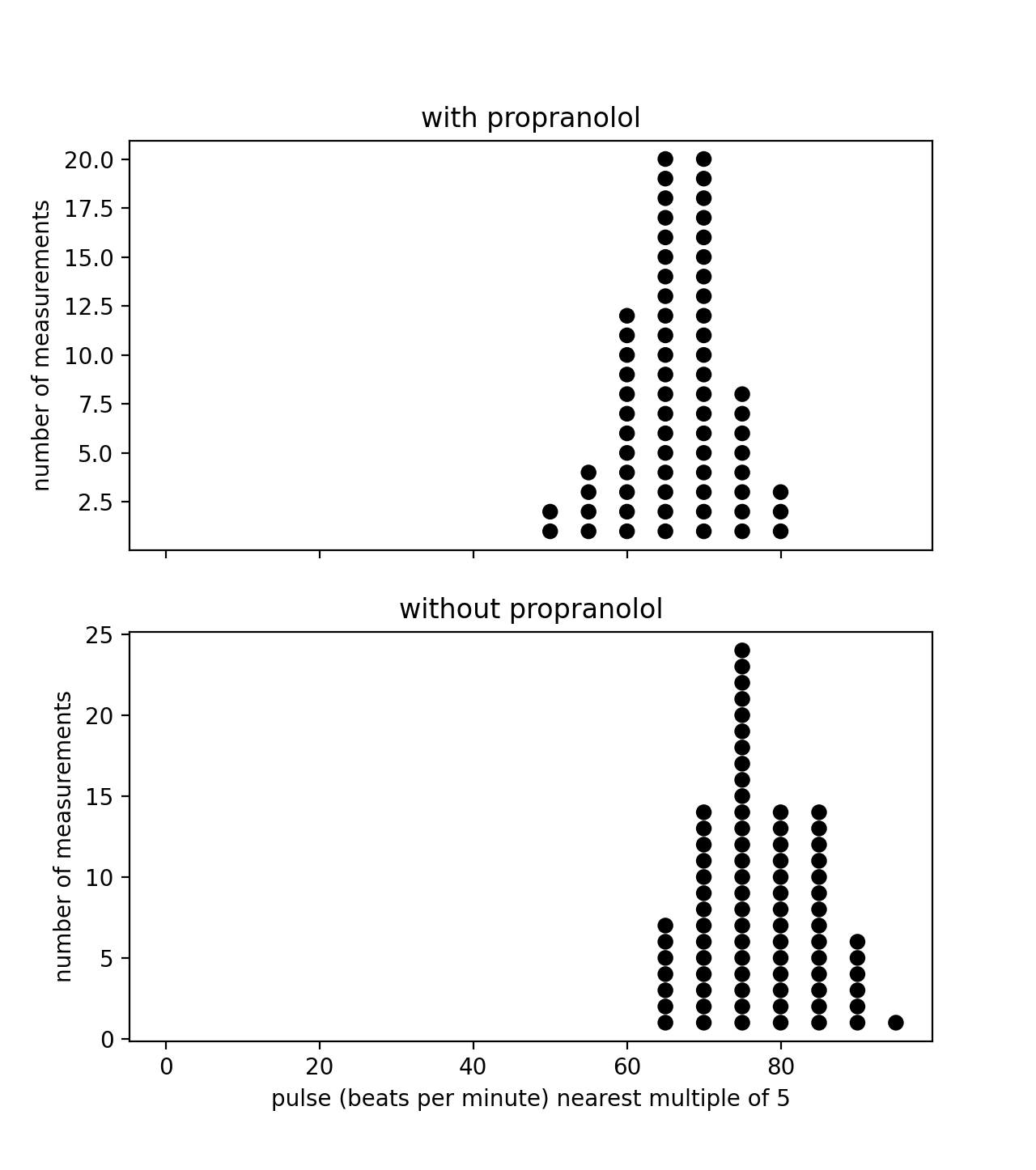
Propranolol did not correlate significantly with any metric of my headache condition. So I know it affected me, but it did not benefit me. So I am unlikely to try it any more.
Amitriptyline
Amitriptyline is the most harmful medication I have tried. Amitriptyline was the first treatment prescribed my first neurologist. I was prescribed 25mg amitriptyline per day, to be taken in the evening. I tried amitriptyline in early 2020 (before covid).
The physical effects from starting and continuing amitriptyline were weak. The clearest effect was dry mouth. But there were harmful mental effects that started while I was still taking amitriptyline regularly, which I describe below. Withdrawing from amitriptyline was the most severe medication-induced experience I have ever had. I withdrew from amitriptyline after taking it on 18 consecutive evenings. On the first night of reduced amitriptyline levels, I had severe sweating, making my pillow very, very wet. On the second night, I was completely unable to sleep; I did not sleep a single minute. I had extreme nausea for the first 4 days of reduced amitriptyline levels. After I took a few bites of a slice of pizza, I spent the next 15 minutes gasping for air. I found applesauce to be the most effective food. I was very weak and spent most of the time laying in my bed. I also felt cold and needed to wear a jacket indoors.
Amitriptyline also had strong effects on my mental state. I became delusional while I was on amitriptyline. I came to believe natural coincidences were signs from super-human intelligence (such as a god or aliens). On day 16 of amitriptyline, I discovered some natural coincidences that I thought proved super-human intelligence, and at that point I decided to withdraw from amitriptyline. From what I wrote during withdrawal, it is clear that I was completely delusional, perceiving significance in trivial personal events including hearing a bird outside and getting a junk text message. Over the months following the withdrawal, I investigated the natural coincidences using computer simulations, which you can find at this link (they all come from astronomy). It took months for all the delusional beliefs to be overturned in my mind, as I had believed there was more than enough significance to prove super-human intelligence. Once I had rejected the significance of all the coincidences, it appeared that it was a delusion caused by amitriptyline. But looking at my written records, I was interested in the possibility of finding signs from super-human intelligence in the weeks before I took amitriptyline, although I did not come to believe that there was proof of super-human intelligence until my 16th day on amitriptyline. So I am not sure to what degree amitriptyline caused these delusions, but it definitely had strong mental effects.
Escitalpram (Lexapro)
I first took escitalopram against my will in a mental hospital in 2019. In summer 2021, I asked my neurologist for escitralopram because I wanted to gain experience with it on my own terms. My neurologist prescribed 10mg per day at bedtime.Here is what I know about escitralopram's effects on me:
-
Escitalpram causes insomnia. I thought escitralopram was not affecting me until I looked at the output from one of my python programs called offset_spearman.py. This program uses scipy.stats.spearmanr to get the Spearman correlation coefficient and p-value between numerous pairs of attributes with one attribute shifted by a number of days called the offset. The program tries offset values -1, 0, 1, and 2. I have been recording an integer called sleepdifficulty every day. Between 2021-07-01 and 2021-10-01, the spearman correlation coefficient between escitalopram in the evening and sleepdifficulty on that night was 0.38, with p-value 0.0002.
Technical note: This python program treats the days as non-sequential, but days are sequential. So I must consider the sequentiality of the data as a possible cause of significant p-values (it has been the cause in some analyses I have done). Here is some evidence against sequentiality being the cause here:- With this date range, sleepdifficulty does not correlate with itself with offset=1 (from one day to the next).
- None of the other day offsets had a significant p-value.
- Escitalpram causes nausea. For this, I searched my records for the words "nausea" and "vomit" (I often wrote that I "feel like vomiting"). I created a column of integers based on my text records. Between 2021-07-01 and 2021-10-01, the spearman correlation coefficient between taking escitalopram in the evening and nausea the next day was 0.35, with p-value 0.0006. None of the other day offsets have a significant p-value.
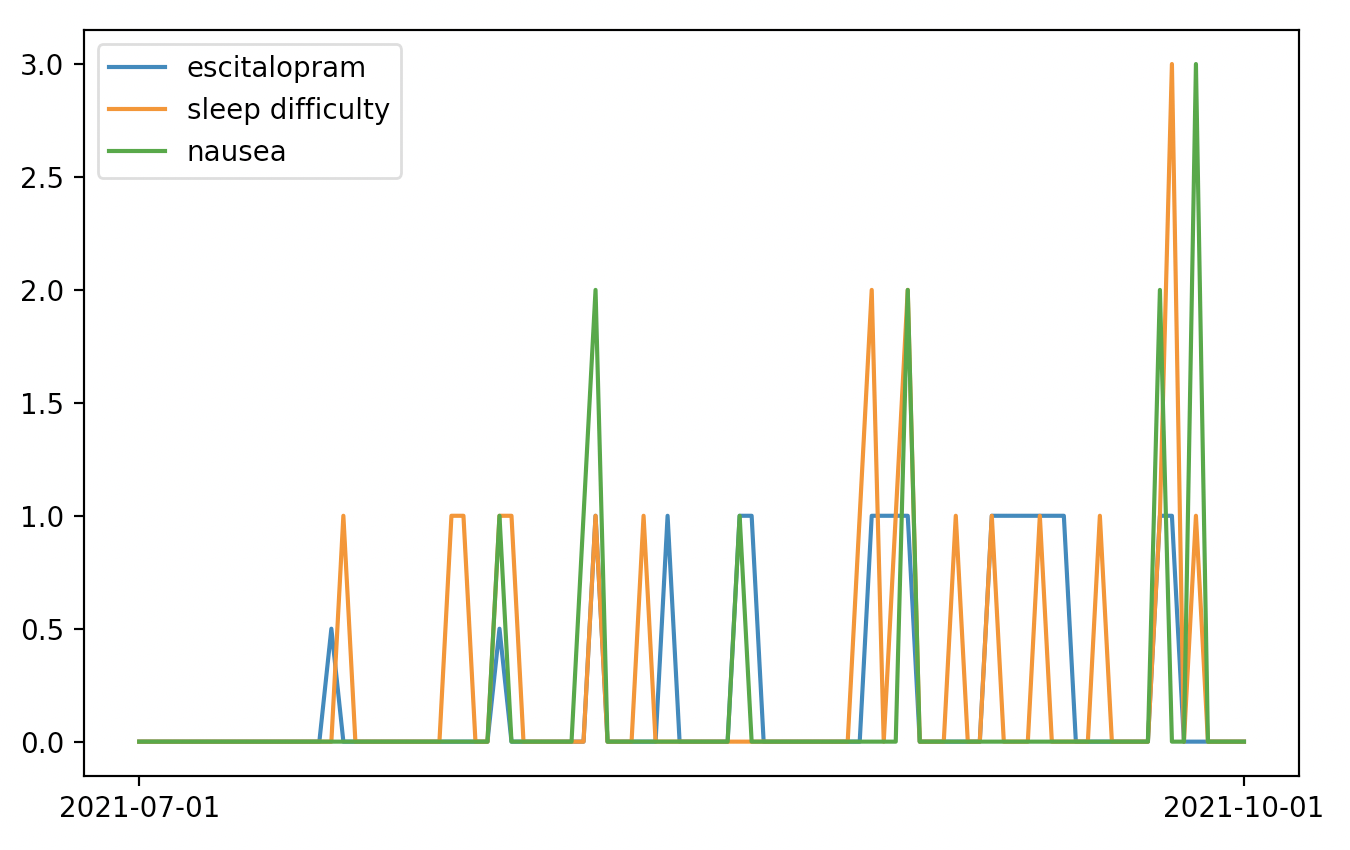
Escitalopram did not correlate significantly with any metric of my headache condition.
Topiramate
In April 2021 I asked my neurologist for topiramate and they prescribed it. After trying topiramate for over 6 months, I finally noticed an effect by withdrawing from 75mg per day. Withdrawal from 75mg per day caused sleep difficulty and strong nausea lasting about a week. Here is the graph showing this: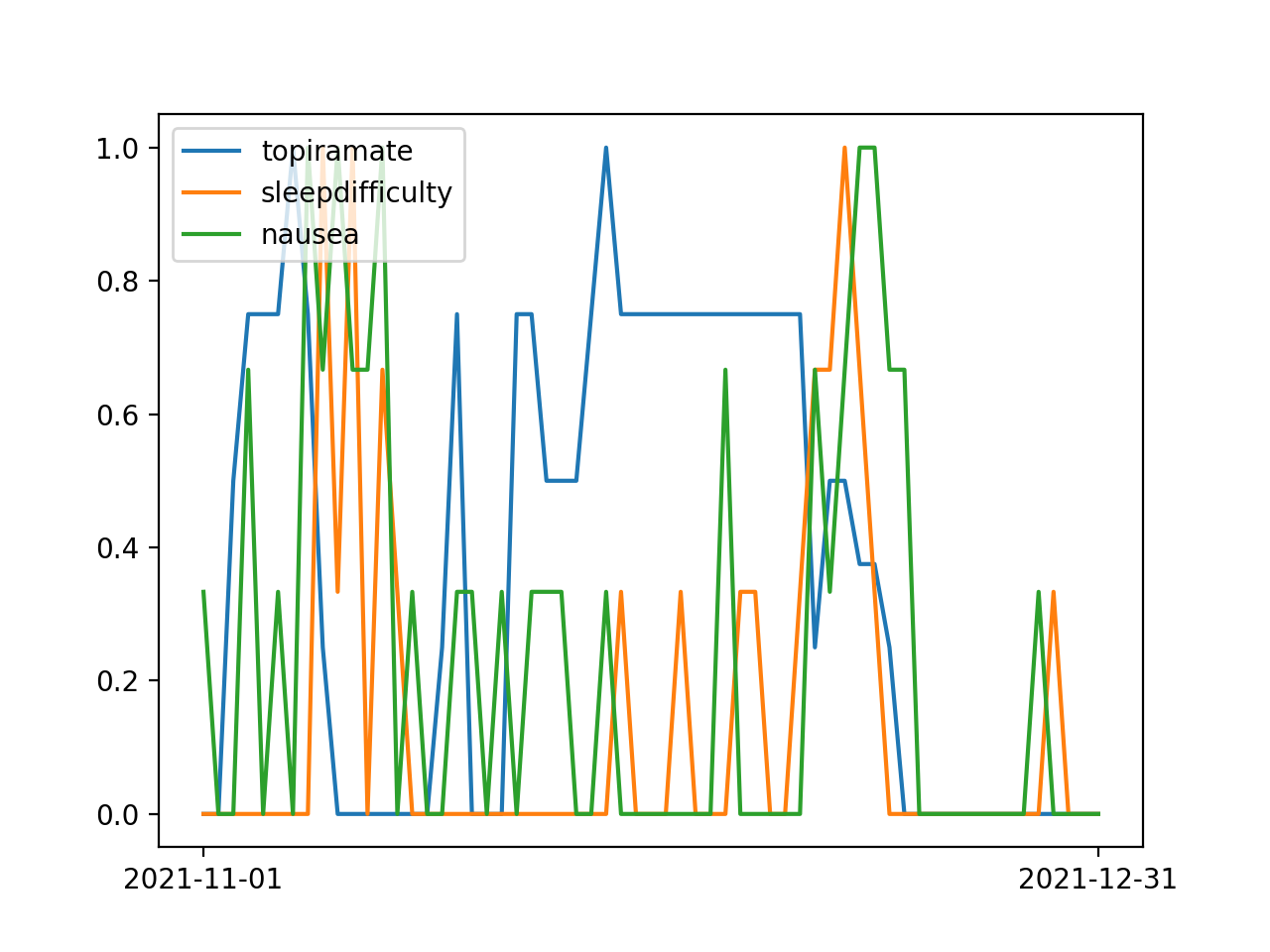
Topiramate taken after noon is counted on the next day in the above graph, representing when the topiramate is in my blood. The highest level of the topiramate line is 100mg, which occurred on 2021-11-07 and 2021-11-28 as I took 4 25mg topiramate tablets on the evening before each of those 2 dates. All 3 lines were normalized to range from 0 to 1.
That graph shows 2 topiramate withdrawals:
- The first withdrawal was because I got sick with a virus starting 2021-11-08. I stopped taking topiramate, incorrectly thinking this was safer than continuing topiramate. When I had the sleep difficulty and intense nausea, I thought it was an effect of the virus. But now I know these were effects of withdrawing from topiramate. The actual effects of the virus were bilateral headache and fatigue which lasted only 3 days. I know it was a virus because others around me were also sick.
- The second withdrawal was because I forgot to take topiramate on the evening of 2021-12-11. I tried to combat the withdrawal with some topiramate, as you can see in the graph. During this withdrawal there were clear mental effects.
Foods
Every day for over 2 years, I recorded a list of foods I eat. I used a python program to analyze this data. There are no noteworthy correlations between the troublesomeness of my condition and any of more than 50 foods.